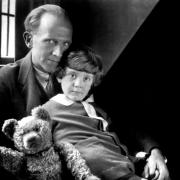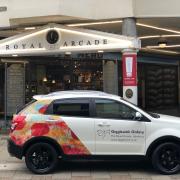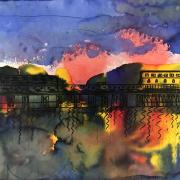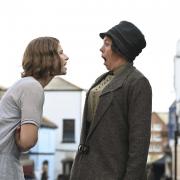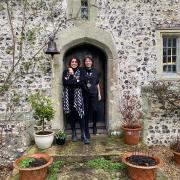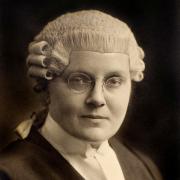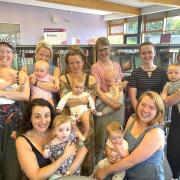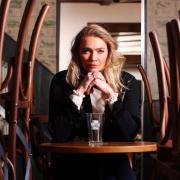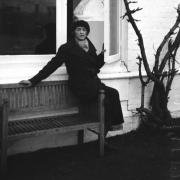Hastings-based cartoonist Martin Honeysett spent almost five decades skewering the ridiculousness of society. Duncan Hall visits a celebration of his work in his home town

The changes in Martin Honeysett’s hometown can be seen in two images he drew 20 years apart.
A bearded and terrifying street drinker stares directly at the viewer out of Welcome To Hastings with a can of extra strength lager in his hands. At the back of the picture a group of knapsacked tourists block the pavement on a boarded-up street, while an old lady struggles to get by.
Painted sometime between 2012 and 2014, The Thinifers and The Fattypuffs is a portrait of the divisions in contemporary Hastings. While the tourist Fattypuffs pile into the colourful amusement arcade, ice creams in hand, the spikey, arty Thinifers cluster around the blackness of the Jerwood Gallery, as in the distance a familiar-looking artist advances, dead shark under his arm, and fishermen behind him protest.
Both vicious and unforgettable images are on display in A Taste of Honeysett, a retrospective exhibition in memory of the Punch and Private Eye cartoonist who died suddenly of septicaemia two years ago aged 71. The darkness of Martin’s images contrasts with the memories of his partner of 19 years, Penny Precious.

“He was a very mild and modest man,” she remembers. “He had a wicked sense of humour, some of it quite vile, which I think he got out on paper. He was a great one for debunking the pompous. His work represents the absurdity of some of our behaviour.”
Hastings is one of the areas touched on in the exhibition, which comes to the town’s Museum and Art Gallery in Bohemia Road five months on from its debut at London’s Cartoon Museum. For this show, at the museum where she used to work, Penny has upped the amount of Sussex-based imagery including one of three ladies from a coach trip enjoying an ice cream in Hastings which she took from her wall at home. “I wanted to keep it for this show,” she says.
As the punning title suggests this exhibition is very much a taster of Martin’s wide and varied career, from his broader work for Punch magazine, to his sharper more acidic cartoons for Private Eye. Also included are lavishly worked original illustrations for the likes of The Goons, Sue Townsend, Pythons Michael Palin and Terry Jones and Scottish humorist Ivor Cutler alongside selections from his own range of books.
Penny has included some unpublished pieces and pencil drafts to show his process, as well as some award-winning images from his two years as a professor of cartooning at the Kyoto Seika University in Japan. The image of Japanese artist Hokusai in his studio trying to capture his famous wave image with the help of an assistant and a bucket of water underlines his amazing skills with the pen.

“He saw himself as a cartoonist first and foremost,” says Penny. “When asked if he was an artist he would hum and ha about it. He would say ‘There’s no such thing as art, just artists’.”
Penny, who studied art at St Martin’s College before specialising in arts management, met Martin 20 years ago at the Cinque Ports Arms in Hastings through a mutual friend. It was his gentle manner which attracted her. “Somebody in the pub attacked me for my views on something. Martin came to my rescue and told the chap to ‘steady on’. He was really protective – I almost fell in love with him straight away he was so sweet.
“What you saw in the drawings was very different from what he was as a person. He was from an ordinary working class background – and perhaps that’s why he focused more on ordinary folk and more day-to-day things. It might be why people respond to it so well.” Indeed looking through the exhibition there is very little need for explanatory notes or context. Many of the cartoons deal with universal experiences and themes, which may have just come up in the news at that point. The only political figures appear in a whack-a-mole machine populated by David Cameron, Gordon Brown and Nick Clegg from the 2010 general election. The rest are easily recognisable figures: unnamed royalty, wild children, upper class twits and the downtrodden in society. The class divide in his cartoons is perhaps best shown in an untitled 1998 Private Eye piece set at a wine-tasting, where a ragged tramp is gratefully catching in his mouth the wine spat out by an upper-class wine-taster.
The exhibition is the backbone for the Hastings and 1066 Cartoon Festival – which in October saw cartoonists and artists take over The Stade Open Space in Rock-A-Nore Road for a day of live art. “It’s not just about the 950th anniversary of 1066,” says Penny. “It also covers issues of invasion, race, identity and the challenge that change and conflict can bring. We are addressing these issues in a way that makes them more fun and accessible.”
And it is that accessibility which makes this exhibition so unmissable. The idea of cartooning or illustration as a throwaway art form is completely debunked when art of Martin’s calibre is on show. It underlines how cartooning can be such an accessible art form – focusing on getting across an idea simply and quickly for maximum effect.
“Martin never earned a lot of money,” says Penny. “But he made a huge amount of work. He read the newspaper endlessly every day to see what the latest issues were and would send different ideas in. We could do another two or three exhibitions as we still have a big spread of his work.” Once the exhibition is over she plans to sell some of the originals to fans to ensure they continue to provide enjoyment.
“The key thing for this exhibition is as a vehicle to reach out to whole other communities that don’t normally take part in historical and cultural outlets,” she says. “We want to reach as many people as we can.”
A Taste of Honeysett is at Hastings Museum and Art Gallery in Bohemia Road until Sunday 8 January 2017. The exhibition will change and develop over the next few months with Penny planning to add some of Martin’s Christmas designs for Private Eye’s range of cards.
It is part of the 1066 Cartoon Festival, which features a series of workshops and events at the museum.
For more information visit www.1066cartoonfestival.co.uk




